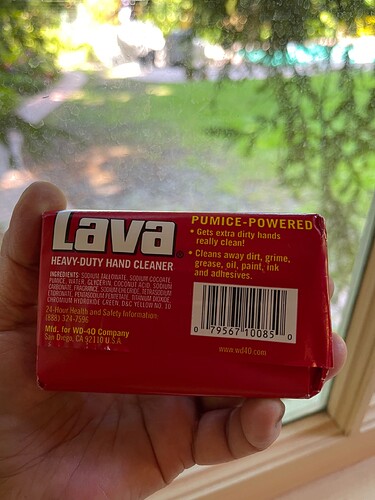Hi,
I just wanted to say how much I love Lava soap for cleaning my hands in the studio…it works really well to remove polishing compounds and oil and grease from my hands…and jewelry parts too!
It can be a bit elusive…i buy a few bars whenever i see it on the store shelves.
I just learned something new about Lava soap…and why it works so well to leave my hands feeling clean and not oily!
note- it can be drying to your skin
the first ingredient is Sodium Tallowate:
(it has Pumice in it too)
(below are quoted from the above link)
"From a chemistry standpoint, a [true soap has to contain some type of either fat or oil] and most of the things we actually use are detergents, and don’t contain any fat.
But sodium tallowate does, in fact, adhere to the traditional chemical composition of a real soap, and can be used solo as such or incorporated into cleansers."
"What Is Sodium Tallowate?
Sodium tallowate is a combination of tallow—a fat that is derived from the fatty tissue of sheep or cattle—and lye, explains Shrestha. (Lye is also known as sodium hydroxide, and is an essential component in a true soap.)
When the two are mixed via a chemical process known as saponification, you get a true soap. Fun fact: Sodium tallowate is actually considered one of the first soap formulations in human history, Shrestha points out. Its use goes all the way back to ancient Roman times. These days, a quick Google search yields plenty of DIY recipes for making this type of tallow soap, and companies also use it as a base in many large-scale formulations.
Benefits of Sodium Tallowate for Skin
“Sodium tallowate is either used as a soap in and of itself or in cleansers, as a surfactant,” says Shrestha. "Thanks to its molecular structure, it’s able to remove dirt and oils from the skin. It bonds with both water and oil, and is able to break the surface tension that in turn allows dirt and oil to easily be washed off by water molecules.”
Simply put, it’s degreasing the skin, says Rossi. While theoretically this is a good thing, both of the experts we spoke with were quick to caution that this is one instance where you can easily veer into that ‘too much of a good thing’ category.
Side Effects of Sodium Tallowate
Generally speaking, sodium tallowate is a relatively safe ingredient. The Environmental Working Group gives it an ‘A’ rating, noting a low level of concern for things such as allergies (more on that point in a moment) and developmental and reproductive toxicity, as well as environmental impact. However, that certainly doesn’t mean it can’t have negative effects on your skin. In fact, the experts we interviewed were hardly eager to recommend this as an ingredient people should be actively seeking out.
“Sodium tallowate can easily be over-drying for many, especially when it’s mixed with fragrances or dyes,” cautions Rossi.
In the process of doing its de-greasing duties, “it can strip away necessary oils that help hydrate and protect the skin,” adds Shrestha. It also bears mentioning that sodium tallowate soaps are more alkaline than others, which can end up affecting the pH of the skin, says Rossi. This, in turn, can trigger inflammation, a compromised skin barrier, and a whole host of other issues.
And let’s not forget the fact that a key component of this ingredient is an animal-derived fat. The tallow in sodium tallowate is a byproduct of the meat industry, so it’s not suitable for vegan or those with vegetarian lifestyles, says Shrestha, who adds that it also may not be sourced ethically.
How to Use It
The bottom line: No matter whether you’re using a straight-up sodium tallowate soap or a cleanser with sodium tallowate in it, less is more. Stick with just once daily usage, and, even more importantly, only use it if you have oily skin, advises Shrestha. Rossi agrees, noting that it’s particularly imperative that those with sensitive or eczema-prone skin steer clear of it, as it can greatly reduce the necessary levels of sebum and moisture in the skin.
Oh, and the topic of sensitive skin, it’s worth pointing out that some sodium tallowate soaps are labeled as hypoallergenic, points out Rossi. While the ingredient itself may be fairly inert when it comes to not triggering allergies, if it’s combined in a formula with other ingredients, you still need to do your due diligence and make sure there’s nothing else in the mix that could cause an allergy, he advises.
Julie

